Impact of Sinorhizobium meliloti Exopolysaccharide on Adsorption and Aggregation in the Copper(II) Ions/Supporting Electrolyte/Kaolinite System
Abstract
1. Introduction
- HMW (high molecular weight) characterized by molecular weight equal to 106–107 Da, as well as
- adsorbed amount measurements of Cu(II) ions and EPS on kaolinite in the single and mixed systems (i.e., containing one or two adsorbates);
- confirmation of Cu(II)/EPS adsorption using scanning electron microscope with EDS analyzer and Fourier transform infrared spectroscopy;
- determination of surface charge density and zeta potential of kaolinite without and with Cu(II) ions and/or EPS;
- aggregation study on kaolinite in the absence and presence of Cu(II) ions and/or EPS using turbidimetry and particle size analyzer (CPS).
2. Materials and Methods
2.1. Materials
2.2. Methods
2.2.1. EPS Isolation
2.2.2. Adsorption Study
2.2.3. Complexes Formation Study
2.2.4. Surface Charge Determination
- supporting electrolyte (0.001 M NaCl or CaCl2);
- supporting electrolyte + kaolinite
- supporting electrolyte + kaolinite + Cu(II) ions;
- supporting electrolyte + kaolinite + EPS;
- supporting electrolyte + kaolinite + Cu(II) ions + EPS.
2.2.5. Zeta Potential Calculation
2.2.6. Aggregation study
3. Results and Discussion
3.1. Mechanism of Copper(II) Ions Adsorption on Kaolinite
3.2. Mechanism of Exopolysaccharide Adsorption on the Kaolinite Surface
- 464.76 and 534.18 cm−1 (corresponding with Si-O stretching vibrations);
- 698.10 cm−1 (attributed to Mg/Al–OH vibrations);
- 800.31 cm−1 (the Si–O–Al group deformation);
- 914.09 cm−1 (the OH bending vibrations of Al–OH);
3.3. Cu(II) and EPS Immobilization on Kaolinite in the Mixed Systems
3.4. Copper(II) ions and Exopolysaccharide Effect on Kaolinite Surface Charge Density
3.5. Exopolysaccharide and Copper(II) Ions Effect on Potential of Kaolinite Slipping Plane Area
3.6. Different Impacts of Exopolysaccharide and Copper(II) Ions on Kaolinite Aggregation
4. Conclusions
- Due to the competition between bidentate cations for access to the adsorbent surface, the Cu(II) adsorbed amount on kaolinite in CaCl2 solution was lower than that in NaCl supporting electrolyte. For initial Cu(II) concentration 100 mg/L, in 0.001 M NaCl 4.36 ± 0.25 mg/g (21.80 ± 1.00%) of the ions was adsorbed, whereas in 0.001 M CaCl2—3.76 ± 0.20 mg/g (18.80 ± 1.00%).
- Regardless of electrolyte type, the experimental data of Cu(II) adsorption isotherms were best fitted to Langmuir model. This indicated, inter alia, that heavy metal ions formed monolayer on the clay mineral surface characterized by uniform adsorption energy. The kinetics of the Cu(II) adsorption on kaolinite were best fitted to the pseudo second-order equation, which meant that the examined phenomenon involved chemisorption.
- The adsorbed amount of exopolysaccharide on kaolinite was larger in the CaCl2 electrolyte than in NaCl one. For initial polymer concentration 100 mg/L, in 0.001 M NaCl the EPS adsorbed amount was 4.69 ± 0.08 mg/g (23.45 ± 0.40%), whereas in 0.001 M CaCl2—5.26 ± 0.15 mg/g (26.32 ± 0.75%). This is a result of the formation of intra-molecular EPS-Ca(II) complexes having more coiled conformation than uncomplexed macromolecules.
- In the mixed system, exopolysaccharide contributed to higher adsorption level of copper(II) ions. What is more, heavy metal ions also make the exopolysaccharide adsorbed amount on the clay mineral larger. The above observations are mainly associated with Cu(II) ions-EPS complexation.
- Adsorption of copper(II) ions and/or S. meliloti exopolysaccharide affected the structure of electrical double layer of kaolinite, significantly. There are clear changes in zeta potential values and surface charge of clay mineral.
- In the samples containing Cu(II) ions and exopolysaccharide simultaneously, the kaolinite aggregation was the strongest. This is mainly dictated by the formation of specific bridges (consisted of polymer chains and heavy metal ions) between solid particles.
- In the environment contaminated with copper(II) ions, Sinorhizobium meliloti exopolysaccharide contributes to a higher immobilization of selected heavy metal as well as stronger aggregation of clay minerals, which is highly desirable in soil remediation technologies.
Author Contributions
Funding
Institutional Review Board Statement
Informed Consent Statement
Data Availability Statement
Acknowledgments
Conflicts of Interest
References
- Kopcewicz, J.; Lewak, S. Plant Physiology; PWN: Warsaw, Poland, 2002. (In Polish) [Google Scholar]
- Janczarek, M.; Mazur, A.; Wielbo, J.; Król, J.; Skorupska, A. Rhizobial exopolisaccharides: Structure, biosynthesis, function in symbiosis. Microbiol. Progres. 1999, 38, 217. [Google Scholar]
- Sutherland, I.W. Bacterial exopolysaccharides. Adv. Microb. Physiol. 1972, 8, 143–213. [Google Scholar] [PubMed]
- Skorupska, A.; Janczarek, M.; Marczak, M.; Mazur, A.; Król, J. Rhizobial exopolysaccharides: Genetic control and symbiotic functions. Microb. Cell Fact. 2006, 5, 7. [Google Scholar] [CrossRef]
- Reinhold, B.B.; Chan, S.Y.; Reuber, T.L.; Marra, A.; Walker, G.C.; Reinhold, V.N. Detailed structural characterization of succinoglycan, the major exopolysaccharide of Rhizobium meliloti Rm1021. J. Bacteriol. 1994, 176, 1997–2002. [Google Scholar] [CrossRef] [PubMed]
- Urzainqui, A.; Walker, G.C. Exogenous suppression of the symbiotic deficiencies of Rhizobium meliloti exo mutants. J. Bacteriol. 1992, 174, 3403–3406. [Google Scholar] [CrossRef] [PubMed]
- Zhang, M.K.; Liu, Z.Y.; Wang, H. Use of single extraction methods to predict bioavailability of heavy metals in polluted soils to rice. Commun. Soil Sci. Plant Anal. 2010, 41, 820–831. [Google Scholar] [CrossRef]
- Liang, W.; Shen, Q.; Gao, Y.; Gu, X.; Yang, Z. Use of bentonite to control the release of copper from contaminated soils. Aust. J. Soil Res. 2007, 45, 618–623. [Google Scholar] [CrossRef]
- Kirpichtchikova, T.A.; Manceau, A.; Spadini, L.; Panfili, F.; Marcus, M.A.; Jacquet, T. Speciation and solubility of heavy metals in contaminated soil using X-ray microfluorescence, EXAFS spectroscopy, chemical extraction, and thermodynamic modeling. Geochim. Cosmochim. Acta 2006, 70, 2163–2190. [Google Scholar] [CrossRef]
- Zhang, X.; Wang, X.-Q.; Wang, D.-F. Immobilization of heavy metals in sewage sludge during land application process in China: A Review. Sustainability 2017, 9, 2020. [Google Scholar] [CrossRef]
- Fijałkowska, G.; Szewczuk-Karpisz, K.; Wiśniewska, M. Anionic polyacrylamide as a substance strengthening the Pb(II) immobilization on the kaolinite surface. Int. J. Environ. Sci. Technol. 2020, 17, 1101–1112. [Google Scholar] [CrossRef]
- Szewczuk-Karpisz, K.; Fijałkowska, G.; Wiśniewska, M.; Wójcik, G. Chromium(VI) reduction and accumulation on the kaolinite surface in the presence of cationic soil flocculant. J. Soil Sediments 2020, 20, 3688–3697. [Google Scholar] [CrossRef]
- Jiang, M.-Q.; Jin, X.-Y.; Lu, X.-Q.; Chen, Z.-L. Adsorption of Pb(II), Cd(II), Ni(II) and Cu(II) onto natural kaolinite clay. Desalination 2010, 252, 33–39. [Google Scholar] [CrossRef]
- Wu, P.; Zhang, Q.; Dai, Y.; Zhu, N.; Dang, Z.; Li, P.; Wu, J.; Wang, X. Adsorption of Cu(II), Cd(II) and Cr(III) ions from aqueous solutions on humic acid modified Ca-montmorillonite. Geoderma 2011, 164, 215–219. [Google Scholar] [CrossRef]
- Szewczuk-Karpisz, K.; Wiśniewska, M.; Pac, M.; Choma, A.; Komaniecka, I. Sinorhizobium meliloti 1021 exopolysaccharide as a flocculant improving chormium(III) oxide removal from aqueous solutions. Water Air Soil Pollut. 2014, 225, 2052. [Google Scholar] [CrossRef] [PubMed]
- Vincent, J.M. A Manual for the Practical Study of Root Nodule Bacteria. International Biological Program Handbook No. 15; Blackwell Scientific Publications Ltd.: Oxford, UK, 1970. [Google Scholar]
- Ościk, J. Adsorption; UMCS: Lublin, Poland, 1969. (In Polish) [Google Scholar]
- Mehling, J. Colorimetric determination of copper with ammonia. Ind. Eng. Chem. Anal. Ed. 1941, 13, 533–535. [Google Scholar] [CrossRef]
- Foo, K.Y.; Hameed, B.H. Insight into the modeling of adsorption isotherm systems. Chem. Eng. J. 2010, 156, 2–10. [Google Scholar] [CrossRef]
- Ho, Y.S.; Huang, C.T.; Huang, H.W. Equilibrium sorption isotherm for metal ions on tree fern. Process Biochem. 2002, 37, 1421–1430. [Google Scholar] [CrossRef]
- Ho, Y.S.; McKay, G. Sorption of dye from aqueous solution by peat. Chem. Eng. J. 1998, 70, 115–124. [Google Scholar] [CrossRef]
- Ho, Y.S.; McKay, G. Application of kinetics models to the sorption of copper(II) onto peat. Adsorption Sci. Technol. 2002, 20, 797–815. [Google Scholar] [CrossRef]
- Janusz, W. Electrical double layer at the metal oxide/electrolyte interface in interfacial forces and fields: Theory and applications. In Surfactant Science Series; Decker, M., Ed.; Marcel Dekker Inc.: New York, NY, USA, 1994; Volume 85, Chapter 4. [Google Scholar]
- Oshima, H. A simple expansion for Henry’s function for the retardation effect in electrophoresis of spherical colloidal particles. J. Colloid Interface Sci. 1994, 168, 269–271. [Google Scholar] [CrossRef]
- Wang, H.; Zhou, A.; Peng, F.; Yu, H.; Yang, J. Mechanism study on adsorption of acidified multiwalled carbon nanotubes to Pb(II). J. Colloid Interface Sci. 2007, 316, 277–283. [Google Scholar] [CrossRef]
- Paderewski, M.L. Adsorption Processes in Chemical Engineering; WNT: Warsaw, Poland, 1999. (In Polish) [Google Scholar]
- Zhang, Z.; Xia, S.; Wang, X.; Yang, A.; Xu, B.; Chen, L.; Zhu, Z.; Zhao, J.; Jaffrezic-Renault, N.; Leonard, D. A novel biosorbent for dye removal: Extracellular polymeric substance of Proteus mirabilis TJ-1. J. Hazard. Mater. 2009, 163, 279–284. [Google Scholar] [CrossRef]
- Hoslett, J.; Ghazal, H.; Ahmad, D.; Jouhara, H. Removal of copper ions from aqueous solution using low temperature biochar derived from the pyrolysis od municipal solid waste. Sci. Total Environ. 2019, 673, 777–789. [Google Scholar] [CrossRef] [PubMed]
- Jin, H.; Hanif, M.U.; Capareda, S.; Chang, Z.; Huang, H.; Ai, Y. Copper(II) removal potential from aqueous solution by pyrolysis biochar derived from anaerobiocally digested algae-dairy-manure and effect of KOH activation. J. Environ. Chem. Eng. 2016, 4, 365–372. [Google Scholar] [CrossRef]
- Albrecht, T.W.J.; Addai-Mensah, J.; Fornansiero, D. Effect of pH, concentration and temperature on copper and zinc hydroxide formation/precipitation in solution. In Proceedings of the CHEMECA 2011-‘Engineering a Better World’, Sydney, NSW, Australia, 18–21 September 2011. [Google Scholar]
- Li, H.; Dong, X.; da Silva, E.B.; de Oliveira, L.M.; Chen, Y.; Ma, L.Q. Mechanisms of metal sorption by biochars: Biochar characteristics and modifications. Chemosphere 2017, 178, 466–478. [Google Scholar] [CrossRef]
- Fijłakowska, G.; Wiśniewska, M.; Szewczuk-Karpisz, K.; Jędruchniewicz, K.; Oleszczuk, P. Comparison of lead(II) ions accumulation and bioavailability on the montmorillonite and kaolinite surfaces in the presence of polyacrylamide soil flocculant. Chemosphere 2021, 276, 130088. [Google Scholar] [CrossRef]
- Gild, M.; Sobrados, I.; Rhaiem, H.B.; Sanz, J.; Amara, A.B.H. Alkaline activation of metakaolinite-silica mixtures: Role of dissolved silica concentration on the formation of geopolymers. Ceramics Int. 2017, 43, 12641–12650. [Google Scholar] [CrossRef]
- Tironi, A.; Trezza, M.A.; Irassar, E.F.; Scian, A.N. Thermal treatment of kaolin: Effect on the pozzolanic activity. 11th International Congress on Metallurgy & Materials SAM/CONAMET 2011. Procedia Mater Sci. 2012, 1, 343–350. [Google Scholar]
- Borah, T.; Gogoi, B.; Khataniar, A.; Gogoi, M.; Das, A.; Borah, D. Probiotic characterization of indigenous Bacillus velezensis strain DU14 isolated from Apong, a traditionally fermented rice beer of Assam. Biocatal. Agric. Biotechnol. 2019, 18, 101008. [Google Scholar] [CrossRef]
- Yamashita, F.; Komatsu, T.; Nakagawa, T. Study of metal-polycarboxylate complexes employing ion-selective electrodes. II. Stability constants of copper(II) complexes with poly(acrylic acid) and poly(methacrylic acid). Bullet. Chem. Soc. Jpn. 1978, 52, 30–33. [Google Scholar] [CrossRef]
- Tarabukina, E.B.; Fatullaev, E.I.; Filippov, A.P.; Abzaeva, K.A. Behavior of metal complexes of polyacrylic acid in solutions. Int. J. Polym. Anal. Charact. 2018, 24, 10–17. [Google Scholar] [CrossRef]
- Parks, G.A. The isoelectric points of solid oxides, solid hydroxides and aqueous hydroxo complex systems. Chem. Rev. 1965, 65, 177–198. [Google Scholar] [CrossRef]
- Kosmulski, M. The pH dependent surface charging and points of zero charge. VIII. Update. Adv. Colloid Interface Sci. 2020, 275, 102064. [Google Scholar] [CrossRef]
- Wakatsuki, T.; Furukawa, H.; Kawaguchi, K. Specific and non-specific adsorption of inorganic ions I. Evaluation of specific absorbability by means of minimum concentration for specific adsorption. Soil Sci. Plant Nutri. 1974, 20, 353–362. [Google Scholar] [CrossRef]
- Skwarek, E.; Janusz, W.; Sternik, D. Adsorption of citrate ions on hydroxyapatite synthetized by various methods. J. Radioanal. Nucl. Chem. 2014, 299, 2027–2036. [Google Scholar] [CrossRef] [PubMed]
- Wiśniewska, M.; Szewczuk-Karpisz, K. Removal possibilities of colloidal chromium(II) oxide from water using polyacrylic acid. Environ. Sci. Pollut. Res. 2012, 20, 3657–3669. [Google Scholar] [CrossRef]
- Szewczuk-Karpisz, K.; Wiśniewska, M.; Pac-Sosińska, M.; Choma, A.; Komaniecka, I. Stability mechanism of the silica suspension in the Sinorhiobium meliloti 1021 exopolysaccharide presence. J. Ind. Eng. Chem. 2015, 35, 108–114. [Google Scholar] [CrossRef]
- Birdi, K.S. Handbook of Surface and Colloid Chemistry, 2nd ed.; CRS Press: Boca Raton, NY, USA, 2003. [Google Scholar]
- Rowley, M.C.; Grand, S.; Verrecchia, E.P. Calcium-mediated stabilisation of soil organic carbon. Biogeochemistry 2018, 137, 27–49. [Google Scholar] [CrossRef]
- Wiśniewska, M.; Szewczuk-Karpisz, K. Comparison of stability properties of nanozirconia aqueous susupension in the presence of selected biopolymers. Springer Proc. Phys. 2016, 183, 261–273. [Google Scholar]
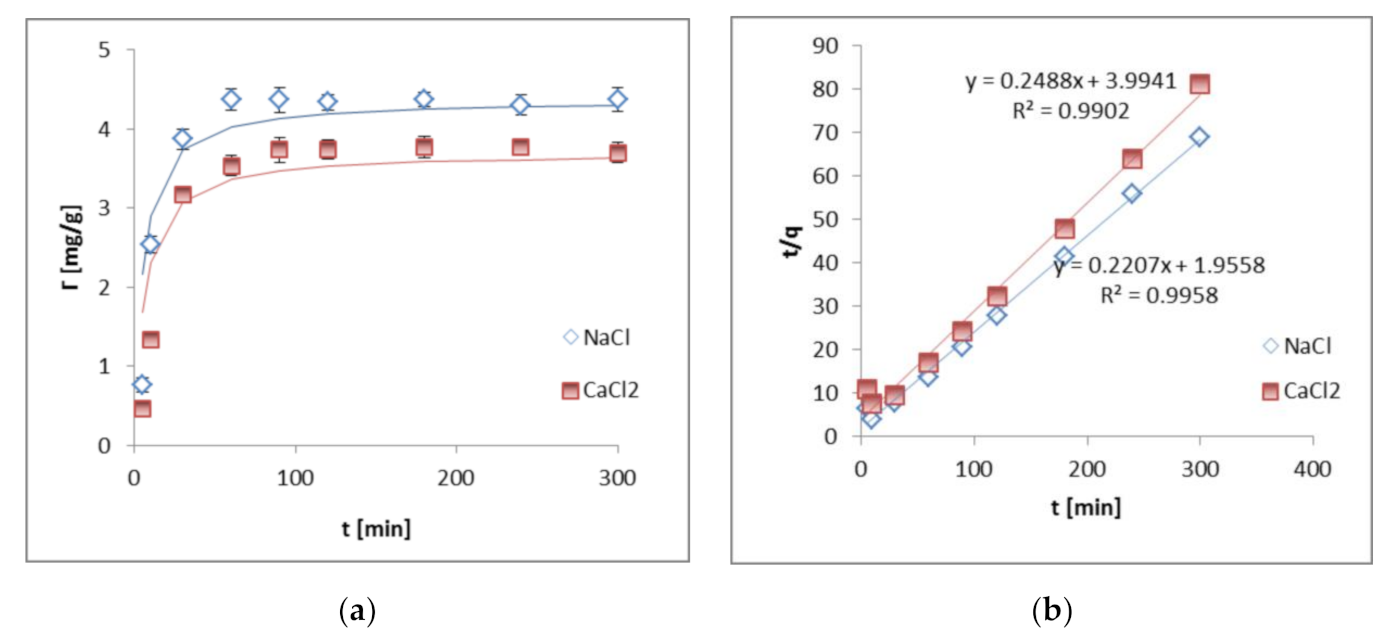
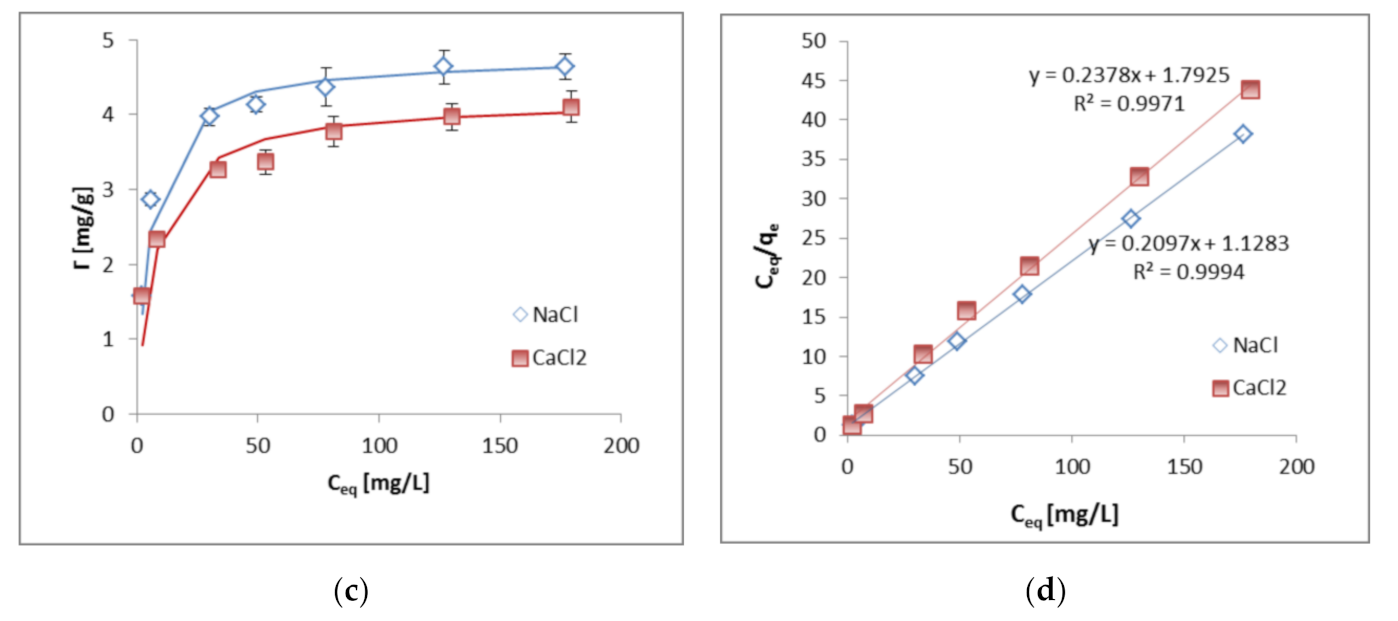
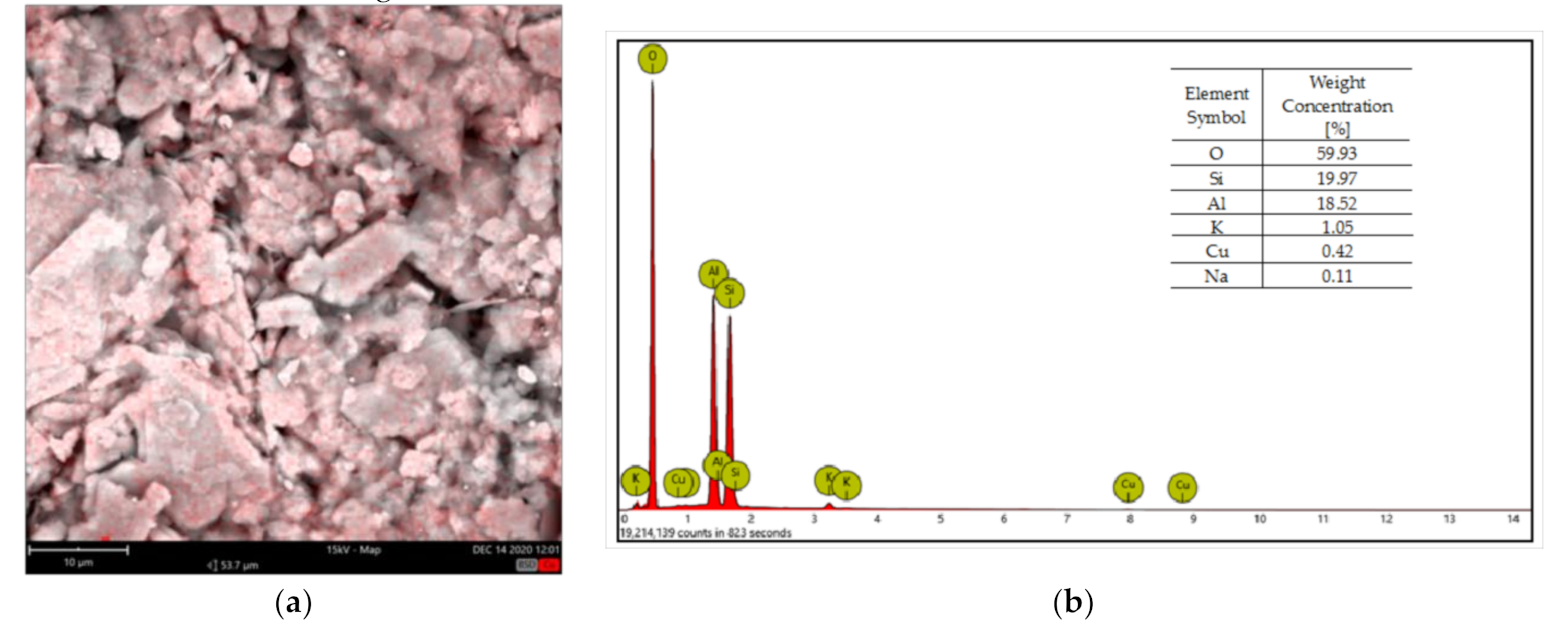
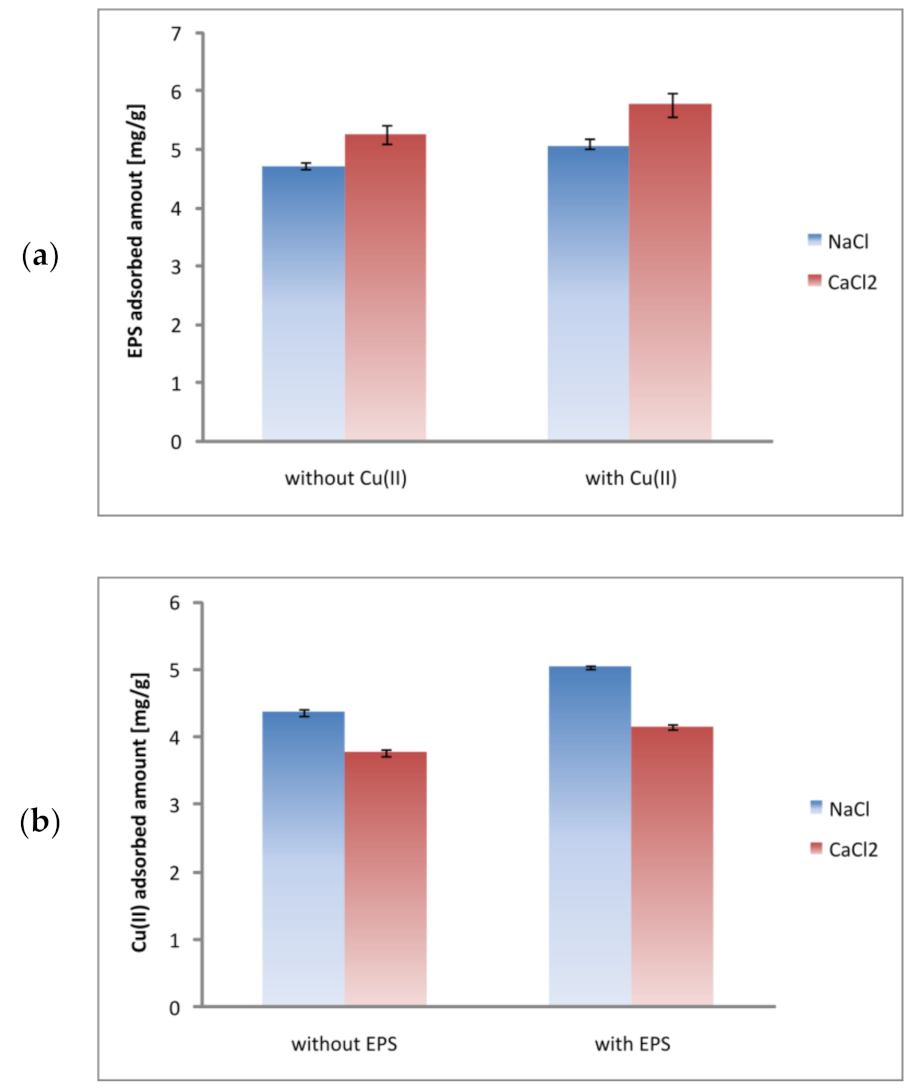
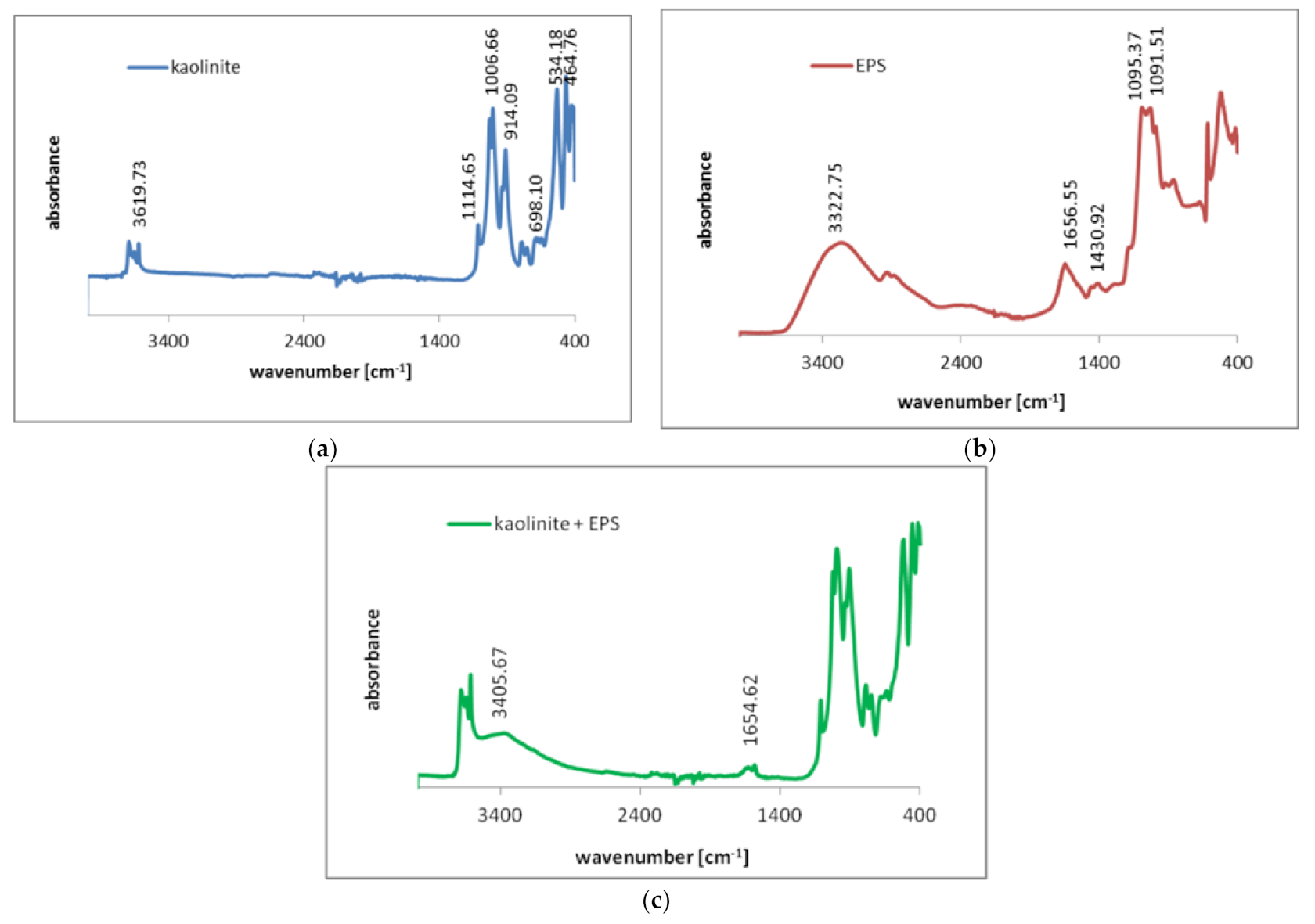
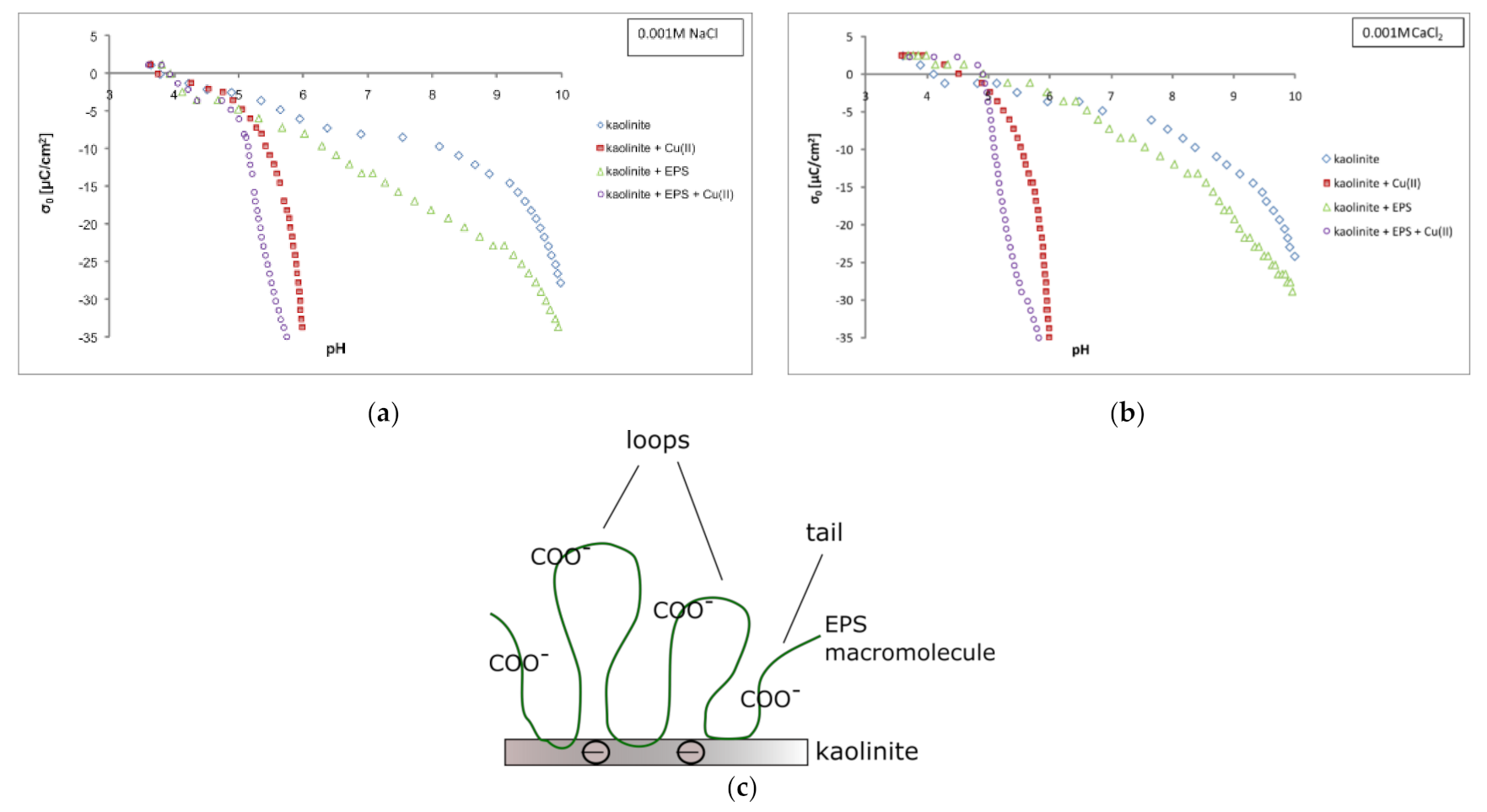
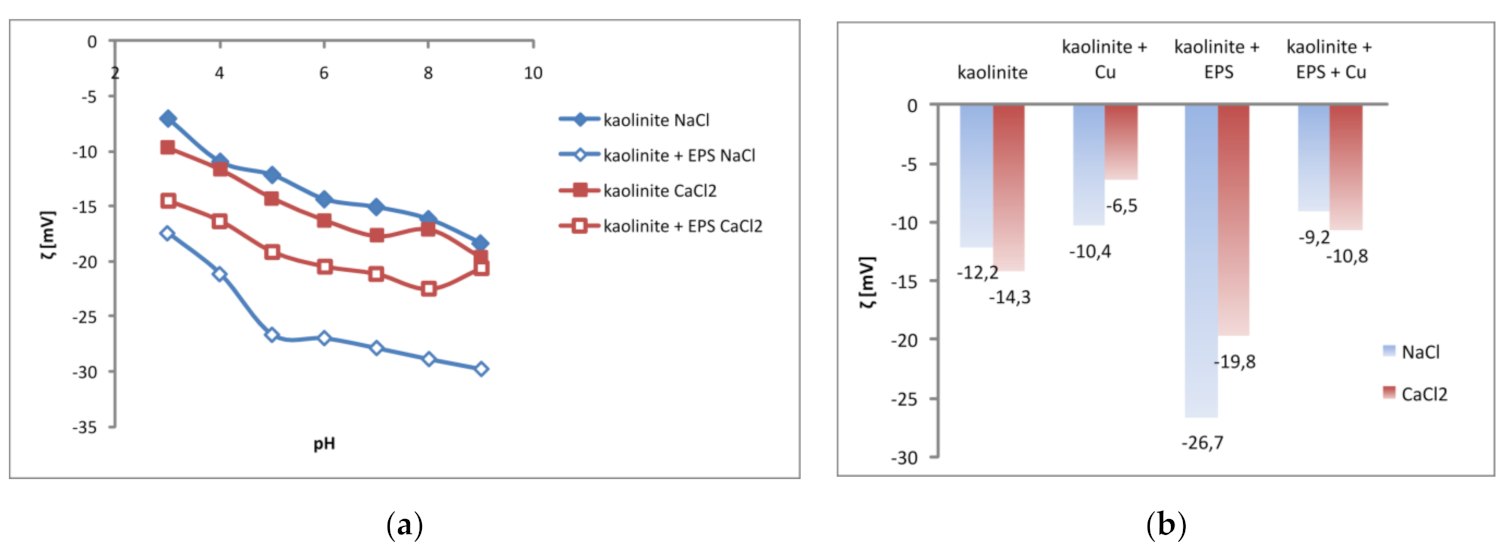

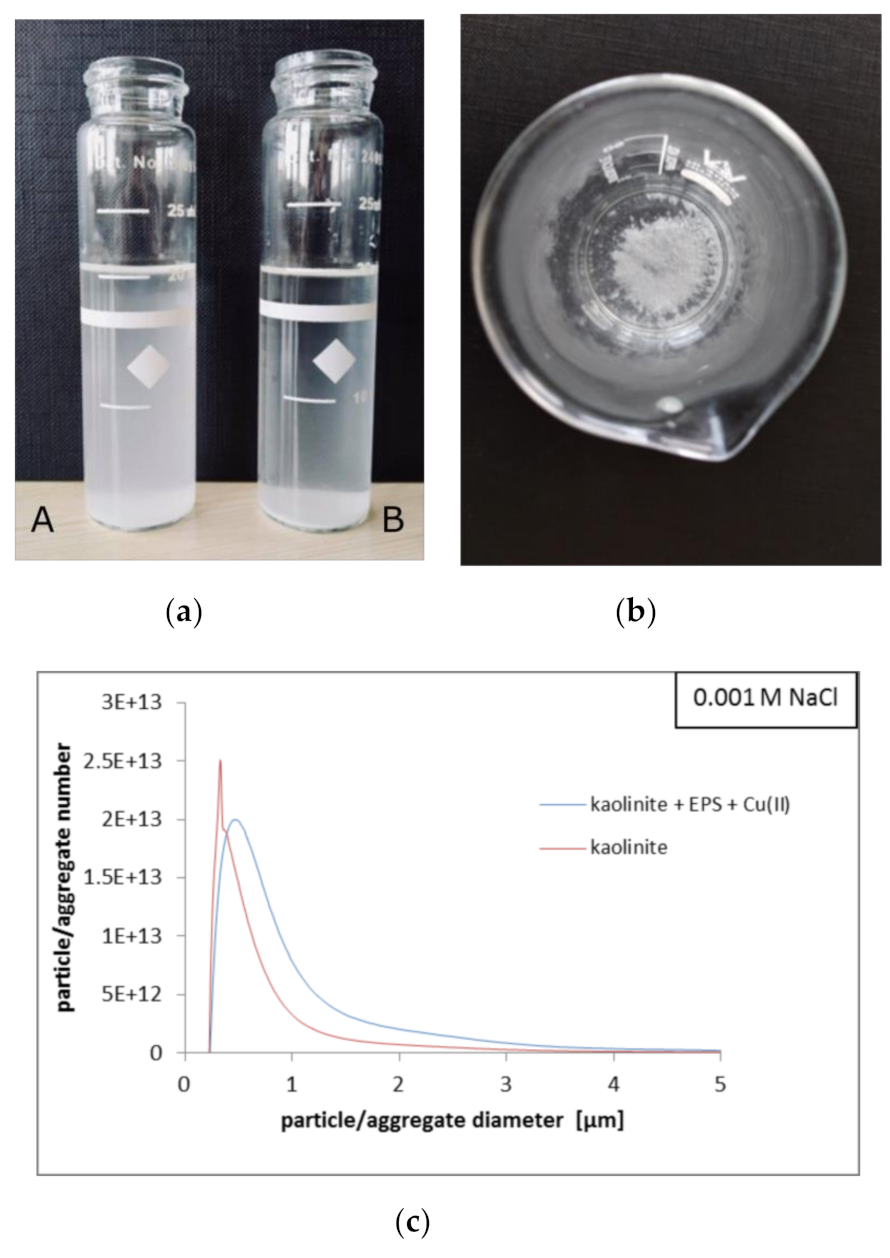
| Pseudo I-Order Equation | Pseudo II-Order Equation | ||||||
|---|---|---|---|---|---|---|---|
| System | qe [mg/g] | k1 [1/min] | R2 | qe [mg/g] | k2 [g/(mg·min)] | R2 | |
| Kinetics | NaCl | 3.136 | 0.0382 | 0.368 | 4.531 | 0.025 | 0.995 |
| CaCl2 | 1.751 | 0.060 | 0.403 | 4.019 | 0.015 | 0.990 | |
| Langmuir Model | Freundlich Model | ||||||
| System | qm [mg/g] | KL [L/mg] | R2 | n | KF [mg/g (mg/L)−1/nF] | R2 | |
| Isotherms | NaCl | 4.768 | 0.186 | 0.999 | 4.454 | 0.218 | 0.887 |
| CaCl2 | 4.204 | 0.132 | 0.997 | 4.950 | 0.260 | 0.947 | |
| System | (µm) | |
|---|---|---|
| Kaolinite | NaCl | 0.329 |
| Kaolinite + Cu(II) | – | 0.401 |
| Kaolinite + EPS + Cu(II) | – | 0.488 |
| Kaolinite | CaCl2 | 0.327 |
| Kaolinite + Cu(II) | – | 0.371 |
| Kaolinite + EPS + Cu(II) | – | 0.241 |
Publisher’s Note: MDPI stays neutral with regard to jurisdictional claims in published maps and institutional affiliations. |
© 2021 by the authors. Licensee MDPI, Basel, Switzerland. This article is an open access article distributed under the terms and conditions of the Creative Commons Attribution (CC BY) license (https://creativecommons.org/licenses/by/4.0/).
Share and Cite
Szewczuk-Karpisz, K.; Tomczyk, A.; Komaniecka, I.; Choma, A.; Adamczuk, A.; Sofińska-Chmiel, W. Impact of Sinorhizobium meliloti Exopolysaccharide on Adsorption and Aggregation in the Copper(II) Ions/Supporting Electrolyte/Kaolinite System. Materials 2021, 14, 1950. https://doi.org/10.3390/ma14081950
Szewczuk-Karpisz K, Tomczyk A, Komaniecka I, Choma A, Adamczuk A, Sofińska-Chmiel W. Impact of Sinorhizobium meliloti Exopolysaccharide on Adsorption and Aggregation in the Copper(II) Ions/Supporting Electrolyte/Kaolinite System. Materials. 2021; 14(8):1950. https://doi.org/10.3390/ma14081950
Chicago/Turabian StyleSzewczuk-Karpisz, Katarzyna, Agnieszka Tomczyk, Iwona Komaniecka, Adam Choma, Agnieszka Adamczuk, and Weronika Sofińska-Chmiel. 2021. "Impact of Sinorhizobium meliloti Exopolysaccharide on Adsorption and Aggregation in the Copper(II) Ions/Supporting Electrolyte/Kaolinite System" Materials 14, no. 8: 1950. https://doi.org/10.3390/ma14081950
APA StyleSzewczuk-Karpisz, K., Tomczyk, A., Komaniecka, I., Choma, A., Adamczuk, A., & Sofińska-Chmiel, W. (2021). Impact of Sinorhizobium meliloti Exopolysaccharide on Adsorption and Aggregation in the Copper(II) Ions/Supporting Electrolyte/Kaolinite System. Materials, 14(8), 1950. https://doi.org/10.3390/ma14081950








